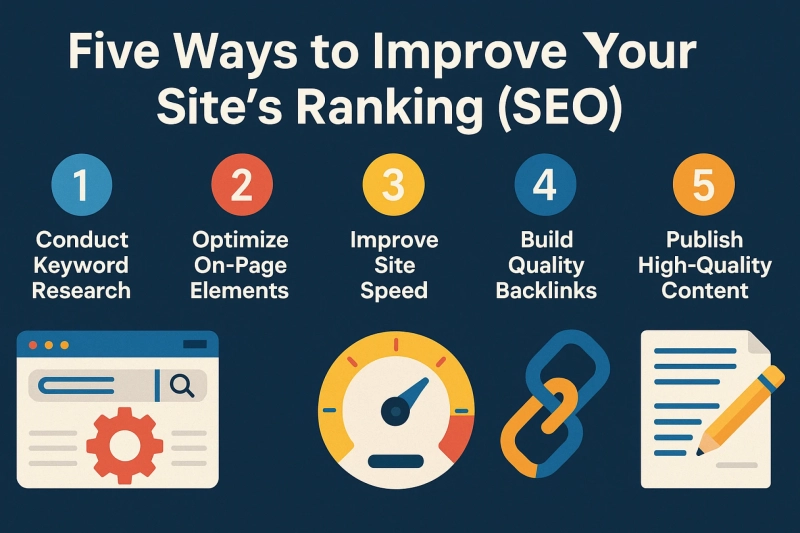SEO is your best friend when it comes to making your website stand out. But let's be real – it can feel like trying to build a house without the proper blueprints. Fortunately, we've got your back. In this guide, we'll walk through five steps to boost your site's ranking and put you ahead of the competition. So, grab a coffee (or tea; we won't judge), and let's dive into SEO like a pro!
Steps to Boost Your Website Ranking
1. Set an SEO Optimization Strategy
Imagine trying to sail across the ocean without a map – that's what tackling SEO without a strategy is like. Setting clear, actionable goals for your SEO efforts is the first step toward success.
Start by understanding what you want to achieve. Are you trying to increase website traffic? Improve your site's visibility on search engines. Or perhaps both? Once you've got that figured out, you can create a strategy that fits. Start with keyword research to identify terms your potential customers are searching for. Tools like Google Keyword Planner or SEMrush can help you discover these keywords. Use a mix of short-tail and long-tail keywords for a well-rounded approach.
But it's not just about picking the right words. Your strategy should include on-page and off-page SEO techniques. On-page SEO is about optimizing individual pages with content and keywords, while off-page SEO focuses on backlinks and external signals that show Google your site is trustworthy.
Remember, SEO isn't something you "set and forget." It's an ongoing process. So, track your progress and be ready to make adjustments when needed.
2. Publish Relevant, Authoritative Content
Let's face it – Google loves content. And not just any content, but high-quality, relevant content that answers users' questions. The trick here is to publish content that engages your audience and establishes you as a trustworthy authority in your field.
If you're writing about coffee (like us – who doesn't love a good brew?), don't just write about "how to make coffee." Go deeper. Discuss the different types of beans, brewing methods, and even the history of coffee. The more in-depth your content is, the more it's likely to be deemed valuable by both readers and Google.
A good rule of thumb? If you're answering a standard question, ensure your content provides a thorough answer. Think of it this way – if your article were a textbook, it should be one people would want to read from cover to cover.
Also, don't forget to use internal linking. Linking to other articles or pages on your site helps Google crawl your content and understand the relationships between your pages. It's like telling Google, "Hey, these pages are important, and here's how they're all connected!”
3. Update Your Content Regularly
SEO is a bit like tending a garden. If you let things grow wild, you'll end up with weeds. The same goes for your website. If your content isn't fresh and up-to-date, it won't rank well.
Search engines, especially Google, love fresh content. They want to serve users with the most relevant, timely information. That means regularly revisiting your old content and updating it with new information. Have industry trends changed? Has there been a new development in your niche? Be sure to add these updates to your existing content.
But that's not all. If you've got outdated blog posts that no longer serve your audience, it's time to hit the reset button. You can either refresh the content or remove it altogether. Google sees this as a sign of an active, valuable site.
4. Have a Link-Worthy Site
When Google looks at your site, one of the most significant factors it considers is the number and quality of external websites linking to yours. These backlinks act like votes of confidence. The more votes you get, the more trustworthy you appear.
However, not all links are created equal. A backlink from a respected website in your industry will carry more weight than a link from a random blog with little traffic. Focusing on getting high-quality backlinks that help build your site's reputation is essential.
To earn backlinks, create content that others want to link to. This can include in-depth guides, original research, or infographics. Once you've got killer content, contact other websites, bloggers, or influencers in your industry and ask them to link to it. It's all about building relationships and creating content that people find valuable enough to share.
5. Optimize for Mobile and Execute Technical SEO
In today's world, if your website isn't mobile-friendly, you might as well be handing your competitors a win. With more and more people browsing on their phones, Google now uses mobile-first indexing, ranking sites based on how well they perform on mobile devices.
Grab your phone and browse your site to check if it is mobile-friendly. Does everything load quickly? Are the buttons easy to tap? If the answer is "no," it's time to adjust.
But it's not just about mobile optimization. You also need to pay attention to technical SEO. This includes ensuring your site has a clean, crawlable structure that allows search engines to easily find and index your content. Things like fast page speed, proper heading tags, and a secure (HTTPS) connection are crucial for maintaining a high-ranking site.
Technical SEO can be tricky, but it's worth the effort. A well-optimized site will rank better and provide a better experience for your visitors.
Wrapping Up
So there you have it! By setting a solid SEO strategy, publishing valuable content, keeping things fresh, building a link-worthy site, and optimizing for mobile, you'll be on your way to boosting your site's ranking. SEO doesn't happen overnight, and it's not about tricking Google into ranking you higher. Instead, focus on providing real value to your visitors. The more you focus on your audience's needs, the more Google will reward you.



